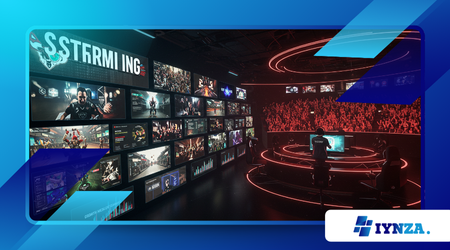The Impact of Streaming on Esports Growth

Ten years ago, esports was still fighting for legitimacy. Today, it’s a billion-dollar industry with packed arenas, corporate sponsors, and millions of fans watching live matches from their phones, tablets, and TVs.
Anúncios
What changed? A lot—but nothing as dramatically as the rise of streaming platforms. The impact of streaming on esports growth can’t be overstated. It’s the engine that turned niche competitions into global spectacles.
In this article, we’ll explore how platforms like Twitch, YouTube, and Kick transformed esports from a subculture into mainstream entertainment, and why real-time viewership has become just as important as the games themselves.
Streaming Made Esports Accessible to the World
Before streaming, watching competitive gaming meant digging through forum links, navigating low-quality video players, or waiting for edited recaps. Live coverage was rare, and discovering new games or players took real effort. Today, anyone with an internet connection can access high-definition, real-time gameplay from anywhere on the planet.
Streaming tore down every barrier to entry. It removed the need for broadcast deals or television networks. All it took was a game, a streamer, and an audience—and suddenly esports became visible, shareable, and most importantly, discoverable.
Fans could now follow tournaments as they happened. Casual players turned into viewers. Viewers turned into fans. And fans became the lifeblood of a new kind of sports culture built on clicks, chatrooms, and clips.
This instant access reshaped what it meant to be a part of the gaming community. Instead of reading about a final match days later, fans could watch it unfold, together, in real time. That shared experience—powered entirely by streaming—was the beginning of something massive.
Read also: Gaming Addiction: How to Find a Healthy Balance
Community Engagement Became the Foundation of Esports Culture
Streaming isn’t just about watching—it’s about interacting. Unlike traditional sports, where the broadcast is one-way, esports streams invite participation. Viewers can ask questions, react in real-time, and even influence what happens on-screen.
This direct connection changed the way players are perceived. Pro players aren’t distant celebrities.
For esports organizations, this opened a new lane of growth. Success was no longer just about winning championships—it was about building engaged, loyal communities. Teams started investing in streamers, content creators, and interactive events to stay connected with their audiences between tournaments.
As a result, the fan experience became personal. That closeness created loyalty. And that loyalty created staying power.
Streaming Platforms Reshaped the Business Model of Esports
Before streaming dominated, esports relied heavily on ticket sales, hardware sponsors, and prize pools. Now, streaming revenue—via ads, subscriptions, and donations—has become a major pillar of financial sustainability.
Tournaments generate revenue not just from attendance, but from the millions tuning in online. Sponsors place ads on streams, partner with influencers, and get visibility during peak viewership. Revenue comes from merchandise, affiliate links, and even emote packs inside Twitch chat.
The decentralized nature of streaming also allows for more frequent, smaller-scale events. You don’t need a stadium—you need a stream key. Weekly online cups, show matches, and charity events now thrive alongside the major global tournaments.
Streaming turned esports into an ecosystem, not just a competition schedule. It created income for players year-round, created space for personalities who weren’t top-tier competitors but knew how to entertain. It opened the door to sustainability, not just stardom.
Global Reach Became Instant and Organic
Traditional sports often struggle to cross borders. Time zones, language barriers, and distribution rights all slow expansion. Esports streaming bypassed all of that.
Games are universal. The visual language of competition needs no translation. A player in Brazil can become a fan favorite in Korea. A tournament in Denmark can gain traction in the Philippines overnight. Twitch, YouTube, and regional platforms allowed fans to self-organize, translate content, and spread highlights in real time.
Streaming enabled a kind of cultural fusion that physical tournaments alone could never achieve. It allowed niche communities to grow rapidly in regions that traditional broadcast systems ignored. And it brought esports to devices and demographics traditional sports still struggle to reach.
Today’s esports fan doesn’t need cable. They need Wi-Fi. That single shift reshaped everything.
One Pattern That Changed Everything
When players could become streamers, and streamers could become celebrities, the definition of “esports success” expanded. It wasn’t just about trophies—it was about consistency, visibility, and influence. The feedback loop between performance and personality created a new kind of esports star.
A Statistic That Proves the Shift
According to Stream Metrics Global, esports-related content on Twitch and YouTube saw a 37% year-over-year increase in 2024, totaling over 1.9 billion hours watched. The League of Legends World Championship alone drew 6.8 million concurrent viewers—nearly tripling the viewership of some traditional sports finals.
Streaming isn’t just boosting esports—it is esports for a growing portion of the global audience.
The Real Question for the Future
If viewership defines success, and streaming shapes viewership, then how will esports evolve as platforms shift, algorithms change, and attention spans shrink?
Will the next wave of esports heroes come from the bracket—or from the stream?
Conclusion
The impact of streaming on esports growth is massive, measurable, and ongoing. It made the games more visible, the players more human, and the fans more connected. It turned performance into content, content into culture, and culture into an industry.
Streaming is more than a delivery method—it’s the stage, the marketing, the revenue model, and the community. Without it, esports might still be fighting to prove itself. With it, it became something the world couldn’t ignore.
The next big team, the next unforgettable moment, and the next legend in the making—they won’t be discovered in silence. They’ll be found live, on stream, with millions watching.
FAQ – The Impact of Streaming on Esports Growth
1. How did streaming make esports more popular?
It made live events accessible to anyone, anywhere, and turned players into creators fans could connect with.
2. Which platforms are most important for esports streaming?
Twitch, YouTube Gaming, and newer platforms like Kick are currently the most influential.
3. Do all pro players stream?
Many do, as it helps build their audience and offers income outside of tournament winnings.
4. Has streaming changed how tournaments are run?
Yes. Many events now prioritize broadcast production, viewer interactivity, and monetization through digital platforms.
5. Can someone become an esports pro by growing on streaming platforms first?
Absolutely. Many players gain visibility through streaming before joining competitive teams.
